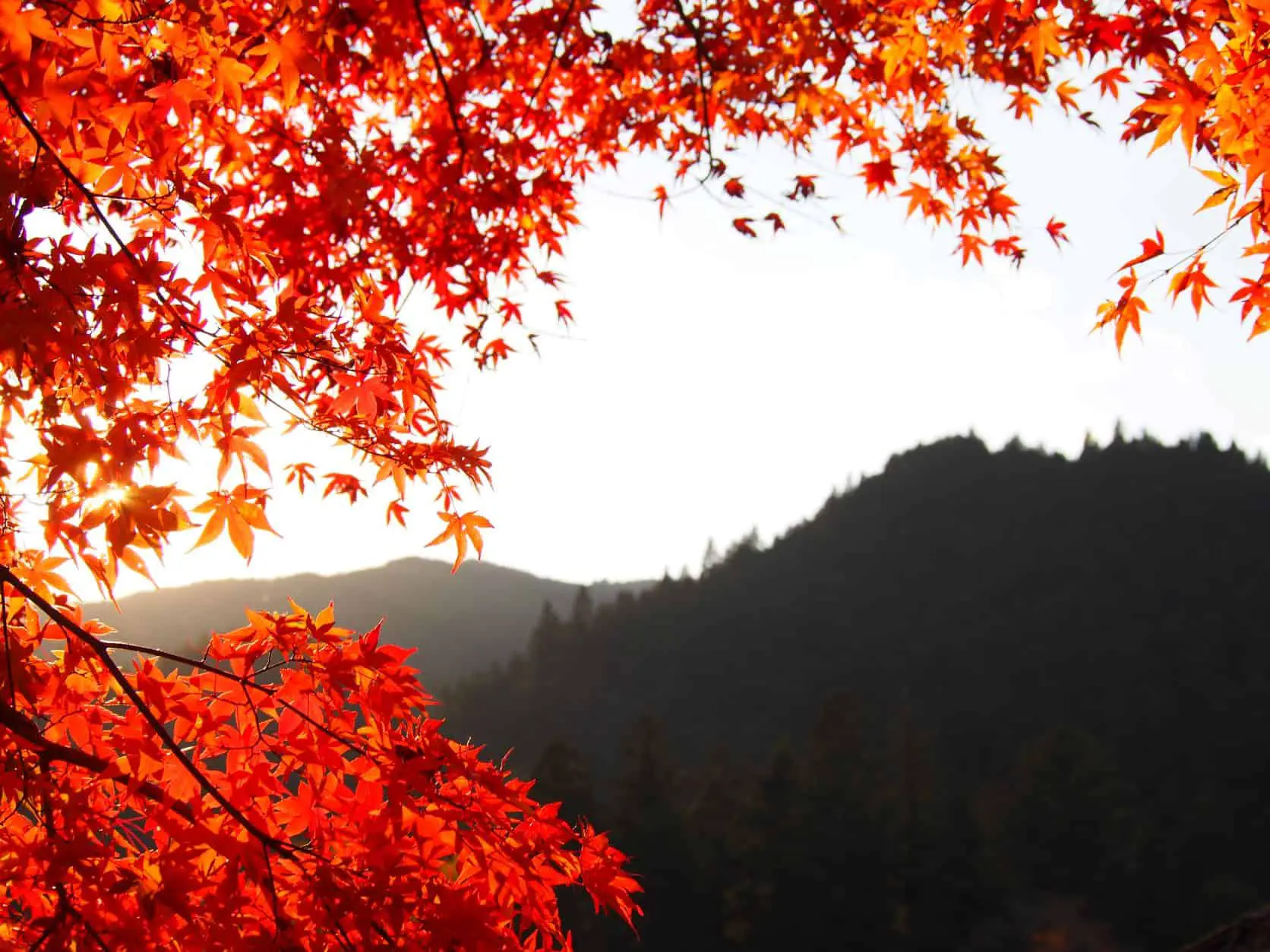In fall, we usually see a natural art show when Japanese maple leaves begin to change from green to yellow and then into vibrant reds. But this does not happen every single year. There are times when Japanese maple bonsai does not turn red enough or shed leaves before turning color.
In this post, I will explain why your Japanese maple bonsai is not turning red and how to make it redder.
Why is my Japanese maple bonsai not turning red?
Before diving into why is your Japanese maple bonsai not turning color, let me explain how it changes color.
How Japanese maple leaves change color
What makes the leaf color
The autumn color change of Japanese maple trees reflects 3 pigments in leaves.
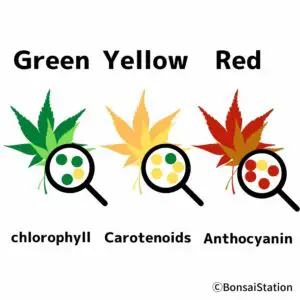
Green/Yellow/Red pigments
- Chlorophyll: Green. It is necessary for photosynthesis, the chemical reaction that enables plants to use sunlight to manufacture sugars for food.
- Carotenoids: Yellow. It absorbs light in wavelengths that chlorophyll is inefficient at absorbing, such as the blue-green to green wavelengths.
- Anthocyanin: Red. It protects leaves from stress caused by extreme temperatures and attacks from herbivores that may be attracted by the green color.
The leaf’s green color is determined by the ratio of the green pigment and the yellow pigment contained in the leaf cell. As the number of yellow pigments increases, the color tone changes from blue-green to yellow-green to greenish-yellow.
In the growing season

Spring leaf
From the beginning of the growing season, Japanese maple trees produce both chlorophyll (green pigment) and carotenoids (yellow pigment) in their leaf cells. Throughout this season, chlorophyll (green pigment) is continually produced while being broken down and thus leaves appear green in spring and summer.
In fall

Fall leaf
As the day gets shorter and the night gets longer in fall, Japanese maple trees start to produce anthocyanins (red pigment) in response to bright sunlight and excess plant sugars within leaf cells.
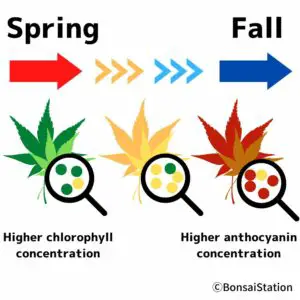
Leaf color change
At the same time, chlorophyll (green pigment) production slows down, stops and then completely breaks down within leaf cells. The carotenoids (yellow pigment) and anthocyanin (red pigment) that are present in the leaf but were then masked by chlorophyll (green pigment) show their true colors, thus autumn leaves.
When Japanese maple leaves change color
The color change of Japanese maple trees is primarily triggered by the following.
- Shorter daytime (longer night-time)
- Temperature changes during the day
- Minimum temperature of below 46° F (8°C)
Shorter daytime (longer night-time)

Shorter day time
In early autumn, the veins that carry fluids into and out of the leaf start to gradually close off as a layer of cells called an abscission zone forms at the base of each leaf, in response to the shortening days and declining temperatures. These clogged veins trap sugars in the leaf and promote the production of anthocyanin (red pigment) by the chemical reaction of sugar and protein.
Temperature changes during the day
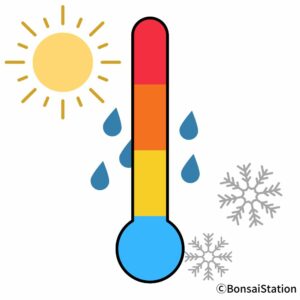
When the temperature is relatively high with warm, sunny daytime which drops to cool and crisp temperatures at night, a lot of sugars are produced in the leaf. But because the cool nights bring the gradual closing of veins going into the leaf, these sugars are prevented from moving out and trapped in the leaf. These conditions, lots of sugar and light, spur the production of anthocyanins (red pigment).
At the same time, chlorophyll is broken down fast when the temperature difference in a day is large. Chlorophyll begins to break down quicker than its production when the temperature drops in the fall. When the temperature difference in the day is large, the breakdown of chlorophyll proceeds well and the composition of anthocyanins in a leaf increases, thus appearing red.
Minimum temperature of below 46° F (8°C)

The leaf color change progresses when the daily minimum temperature falls below 46° F (8°C). If the minimum temperature does not fall below 50 °F (10°C), chlorophyll (green pigment) will not break down much, masking red pigment to reveal. On the other hand, if the minimum temperature drops below freezing, the leaves will turn brown, and then fall off before turning red.
From an empirical standpoint, the leaves of Japanese maple trees change color almost fully in around 3 weeks after the minimum temperature falls below 46° F (8°C).
Why is your Japanese maple bonsai not turning red?
There are four reasons why your Japanese maple bonsai is not turning red:
- Lack of sunlight during spring and summer
- Lack of temperature drop
- Lack of temperature changes during the day
- Lack of moisture in the soil
Lack of sunlight
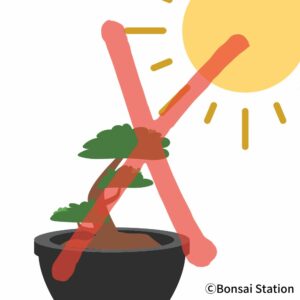
Japanese maple trees have to store enough plant sugar to produce anthocyanins (red pigment) to change leaf color. To do this, they need sunlight as well as carbon dioxide and water for photosynthesis.
If they do not get enough sunlight before the fall season, they lack the energy they need to produce anthocyanins, which makes the leaves look red. Keeping your Japanese maple bonsai indoors will easily lead to a lack of sunlight.
Lack of temperature drop
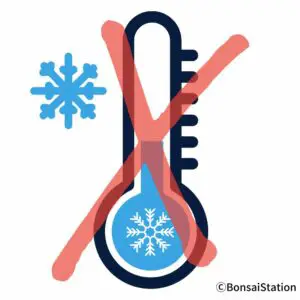
Although it is not scientifically proven to this day, the formation of the separation layer that promotes the production of anthocyanin (red pigment) at a leaf base is in part triggered by a temperature drop in fall.
If warm weather continues in the fall without adequate temperature drop, the production of anthocyanin (red pigment) will not progress for the leaves to change color beautifully.
Lack of temperature changes during the day

Chlorophyll (green pigment) in leaves is broken down fast when the temperature difference in a day is large. Without enough temperature changes during the day, the green pigments continue to remain, masking the red pigment produced in the leaves. A warm period during fall will in fact lower the intensity of autumn colors.
Lack of moisture in the soil
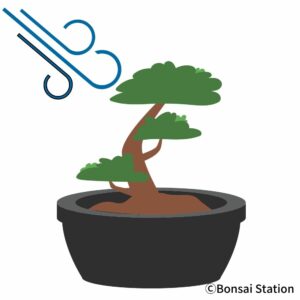
The amount of moisture in the soil also affects autumn colors. A very hot summer without adequate watering will not just delay the onset of fall color but also cause irremediable leaf scorch.
Favorable spring/summer weather with adequate sunlight and rains, in addition to warm sunny fall days with cool nights, will produce the most brilliant autumn colors.
How to make your Japanese maple bonsai redder
Change the amount of sunlight it gets

The amount of sunlight the Japanese maple bonsai gets is crucial for the beautiful color change as sunlight is essential to produce energy and red pigment in leaf cells. Adequate sunlight for the autumn colors is as follows.
- Early spring to mid-July: The tree should be fully exposed to sunlight.
- From late July to early September: Give the tree enough sunlight in the morning and shade it with a sheer cloth to avoid strong afternoon sunlight. During the night, remove the shade and expose it to night dew to give moisture to the leaves.
- From mid-September: Remove the shade and expose the tree to sunlight and rain.
Why make shade in summer
Japanese maples are prone to leaf scorch. Although leaf scorch rarely causes long-term damage to the tree itself, leaves turn brown, particularly around the tips and margins. It is followed by the leaves curling and shriveling if the stress is hard enough.
Leaf scorch occurs when water is lost from the leaves more quickly than the roots can take it up. It often happens during the hot summer day when water is evaporated through leaves but the water absorption by the roots is less than it should be.
There is no cure for leaf scorch, only prevention. Once browned, the leaf cells are dead and unrecoverable to enjoy autumn leaves. This is why making a shade for Japanese maple trees is important.
Give fertilizer with less nitrogen content
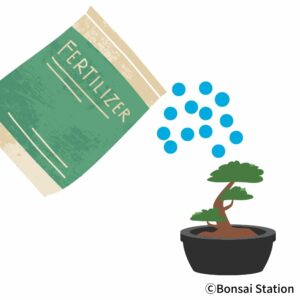
When Japanese maple trees are given fertilizers with less nitrogen content, the leaf color turns brighter red than usual earlier in the season.
With nitrogen-rich fertilizer
Given nitrogen-rich fertilizers, Japanese maple trees grow vigorously. Lots of leaves will come out producing a lot of chlorophyll (green pigment) in their cells for photosynthesis. Although this is good for the health of the tree, leaves might not turn color beautifully because of excess chlorophyll (green pigment).
With nitrogen-deficient fertilizer
With nitrogen deficiency, the leaves of Japanese maple trees produce less chlorophyll (green pigment) which starts to break down earlier. The yellow color from carotenoids thus becomes noticeable from early on.
The breakdown of chlorophyll (green pigment) leads to the production of a lot of anthocyanins (red pigments) from early in the season. Since there is less chlorophyll (green pigment) in the leaf cells to begin with, the leaf color becomes bright and vivid red.
The ideal fertilizer for a fully-shaped Japanese maple bonsai is 4.4% nitrogen, 4.0% phosphoric acid, and 1.7% potassium. Reduce nitrogen and increase the proportion of phosphoric acid and potassium if you want brighter autumn leaves.
Dyna-Gro Bonsai-Pro Liquid Fertilizer
This product contains less nitrogen with emphasis on phosphorus and potassium, which is suitable for Japanese maple autumn colors (NPK ratio- 7:9:5).
Keep in mind that although this is a good way to see beautiful leaf color, the leaves might fall quickly and the growth of trees might not be as good as it should be.
For more about fertilization in the fall, please check the following post.
Defoliate in the right season
The leaves that come out after defoliation are soft with thin layers of cells, which makes leaves susceptible to temperature changes for color change. Defoliation should be done around the beginning of June when most of the new spring leaves have come out. It takes about 2 weeks for the new buds to come out after defoliation and another week for the leaves to open.
Defoliation at the right moment is important because the sugar in the leaf cells will not be sufficient to produce anthocyanins (red pigment) if the leaves are taken off beyond the appropriate time. Autumn leaves need anthocyanins (red pigment) for bright red color.
Things to consider when defoliating
Please note that not all cultivars of Japanese maple can tolerate defoliation as it significantly inhibits growth. Acer palmatum subsp. matsumurae (Koidz) Ogata is one of the cultivars that is known to tolerate defoliation well.
Also, defoliation can only be done to the trees with enough strength to bear the stress, such as younger trees or trees that are given abundant fertilizers the year before.
Water the leaves

When watering Japanese maple trees, give abundant water from above the leaves as well at least once a week to wash away dust and other dirt from the leaves. This will ensure that the leaves get the sunlight they need. Make sure that the soil will not dry out in summer as the Japanese maple leaves need constant moisture in the soil for autumn leaves.
Continue watering the leaves before the tree starts to change color to give the leaves enough moisture.
To know more about the benefits of watering leaves, please read the following post.
After changing color
Reduce the frequency of watering after the leaves start to turn red because the absorption of water from the roots becomes quite low at that time. Make sure, however, that the soil keeps enough moisture as the leaves will die off very quickly in a short period of time when the soil dries out. Exposing the tree to night dew is a good idea as the leaves get water naturally, and the tree gets humidity and fresh air.
It is crucial to avoid frost at this stage. When exposed to frost, the leaf color changes from red to brown in an instant and leaves fall off the tree.
If you want to keep your Japanese maple bonsai indoors to see the autumn leaves, it may not change color brightly. In that case, place your bonsai tree outside during the night to expose it to the night dew and cold air. Also, be sure to give water to the leaves as well.
—–
Reference
US Department of Agriculture (Link here)
“Chemistry of Autumn leaves” (Link here) (in Japanese)

